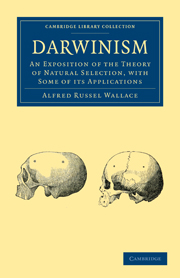Book contents
- Frontmatter
- Preface
- Contents
- LIST OF ILLUSTRATIONS
- CHAPTER I WHAT ARE “SPECIES” AND WHAT IS MEANT BY THEIR “ORIGIN”
- CHAPTER II THE STRUGGLE FOR EXISTENCE
- CHAPTER III THE VARIABILITY OF SPECIES IN A STATE OF NATURE
- CHAPTER IV VARIATION OF DOMESTICATED ANIMALS AND CULTIVATED PLANTS
- CHAPTER V NATURAL SELECTION BY VARIATION AND SURVIVAL OF THE FITTEST
- CHAPTER VI DIFFICULTIES AND OBJECTIONS
- CHAPTER VII ON THE INFERTILITY OF CROSSES BETWEEN DISTINCT SPECIES AND THE USUAL STERILITY OF THEIR HYBRID OFFSPRING
- CHAPTER VIII THE ORIGIN AND USES OF COLOUR IN ANIMALS
- CHAPTER IX WARNING COLORATION AND MIMICRY
- CHAPTER X COLOURS AND ORNAMENTS CHARACTERISTIC OF SEX
- CHAPTER XI THE SPECIAL COLOURS OF PLANTS: THEIR ORIGIN AND PURPOSE
- CHAPTER XII THE GEOGRAPHICAL DISTRIBUTION OF ORGANISMS
- CHAPTER XIII THE GEOLOGICAL EVIDENCES OF EVOLUTION
- CHAPTER XIV FUNDAMENTAL PROBLEMS IN RELATION TO VARIATION AND HEREDITY
- CHAPTER XV DARWINISM APPLIED TO MAN
- INDEX
CHAPTER VIII - THE ORIGIN AND USES OF COLOUR IN ANIMALS
Published online by Cambridge University Press: 29 August 2010
- Frontmatter
- Preface
- Contents
- LIST OF ILLUSTRATIONS
- CHAPTER I WHAT ARE “SPECIES” AND WHAT IS MEANT BY THEIR “ORIGIN”
- CHAPTER II THE STRUGGLE FOR EXISTENCE
- CHAPTER III THE VARIABILITY OF SPECIES IN A STATE OF NATURE
- CHAPTER IV VARIATION OF DOMESTICATED ANIMALS AND CULTIVATED PLANTS
- CHAPTER V NATURAL SELECTION BY VARIATION AND SURVIVAL OF THE FITTEST
- CHAPTER VI DIFFICULTIES AND OBJECTIONS
- CHAPTER VII ON THE INFERTILITY OF CROSSES BETWEEN DISTINCT SPECIES AND THE USUAL STERILITY OF THEIR HYBRID OFFSPRING
- CHAPTER VIII THE ORIGIN AND USES OF COLOUR IN ANIMALS
- CHAPTER IX WARNING COLORATION AND MIMICRY
- CHAPTER X COLOURS AND ORNAMENTS CHARACTERISTIC OF SEX
- CHAPTER XI THE SPECIAL COLOURS OF PLANTS: THEIR ORIGIN AND PURPOSE
- CHAPTER XII THE GEOGRAPHICAL DISTRIBUTION OF ORGANISMS
- CHAPTER XIII THE GEOLOGICAL EVIDENCES OF EVOLUTION
- CHAPTER XIV FUNDAMENTAL PROBLEMS IN RELATION TO VARIATION AND HEREDITY
- CHAPTER XV DARWINISM APPLIED TO MAN
- INDEX
Summary
Among the numerous applications of the Darwinian theory in the interpretation of the complex phenomena presented by the organic world, none have been more successful, or are more interesting, than those which deal with the colours of animals and plants. To the older school of naturalists colour was a trivial character, eminently unstable and untrustworthy in the determination of species; and it appeared to have, in most cases, no use or meaning to the objects which displayed it. The bright and often gorgeous coloration of insect, bird, or flower, was either looked upon as having been created for the enjoyment of mankind, or as due to unknown and perhaps undiscoverable laws of nature.
But the researches of Mr. Darwin totally changed our point of view in this matter. He showed, clearly, that some of the colours of animals are useful, some hurtful to them; and he believed that many of the most brilliant colours were developed by sexual choice; while his great general principle, that all the fixed characters of organic beings have been developed under the action of the law of utility, led to the inevitable conclusion that so remarkable and conspicuous a character as colour, which so often constitutes the most obvious distinction of species from species, or group from group, must also have arisen from survival of the fittest, and must, therefore, in most cases have some relation to the wellbeing of its possessors. Continuous observation and research, carried on by multitudes of observers during the last thirty years, have shown this to be the case; but the problem is found to be far more complex than was at first supposed.
- Type
- Chapter
- Information
- DarwinismAn Exposition of the Theory of Natural Selection, with some of its Applications, pp. 187 - 231Publisher: Cambridge University PressPrint publication year: 2009First published in: 1889



